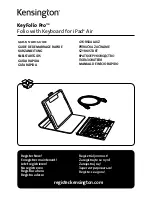
14
IMPORTANT
It is important
to perform
calibration and
subsequent
measurements in
solution with the
same temperature
and salinity.
FIELD
CALIBRATION
For field
calibrations, please
see alternative
calibration
procedure below.
IMPORTANT
Vigorous bubbling
water with any
gas may cause
the water to cool
considerably.
Monitor the
temperature to find
a suitable bubbling
rate, which does
not cool the water
significantly.
Please read the entire procedure below before the calibration is
commenced . It is best to first prepare the Na
2
S stock solution so
it is ready . Then prepare the buffer and perform the calibration
quickly thereafter in order to avoid reintroduction of oxygen .
NOTE: For field calibrations, an alternative method is
recommended - this will enable you to prepare reagents to bring
into the field for easy calibration .
Laboratory calibration
1 . Prepare a stock solution
A stock solution of S
2-
(≈ 0,01M total sulphide) is prepared
anaerobically by dissolving 0,24 g Na
2
S * 9 H
2
O in 100 mL of
N
2
-flushed water in a closed container . The final concentration of
the stock solution should be determined by standard analysis (e .g .
Cline 1969 or Budd & Bewick 1952) . Keep the stock solution out of
contact with oxygen .
2 . Prepare the calibration buffer
Any standard pH buffer, with a pH value less than 4, can be used .
Remove oxygen from a volume of the buffer . This can be done in
two ways:
a . By vigorously bubbling with an
oxygen-free inert gas (e .g . N
2
) for at
least 5 minutes . NOTE: Vigorously
bubbling buffer with any gas may cause
the water to cool considerably . Monitor
the temperature to find a suitable
bubbling rate, which does not cool the
buffer significantly .
b . By adding a suitable reductant (e .g .
Ti(III)Cl; MERCK supplies this in a 10%
HCl solution) to the oxygen free buffer
to a final concentration of 50 mM . Add
a few glass beads (2-3 mm in diameter)
to facilitate mixing . The transfer is










































